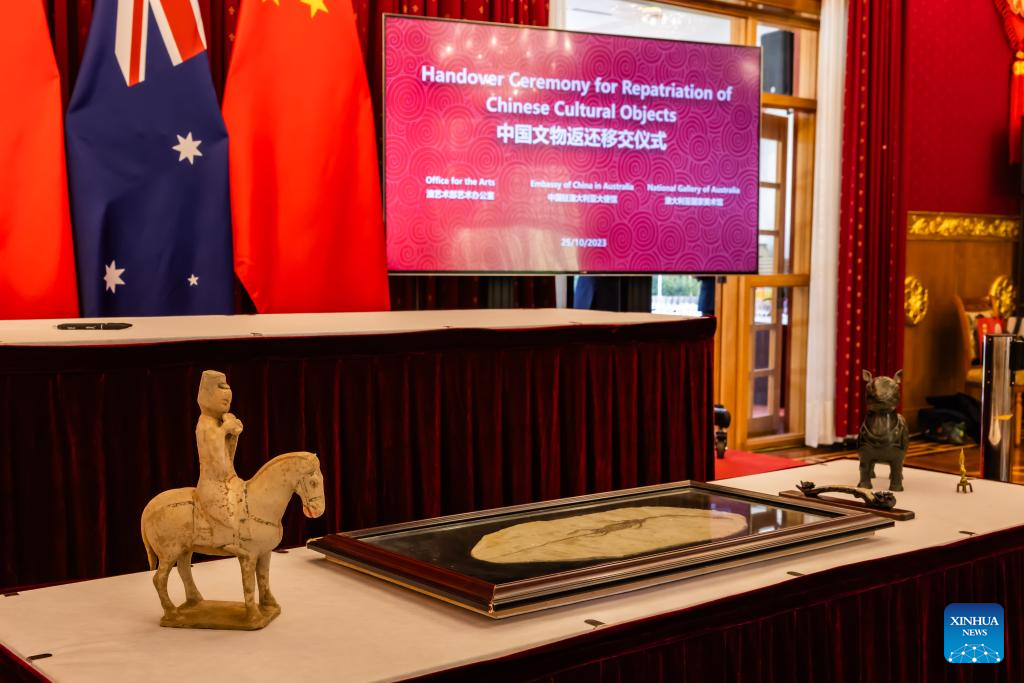
A Buddhist gilt bronze figurine of Bodhisattva Avalokiteshvara is displayed at a handover ceremony for the repatriation of Chinese cultural objects at the Chinese embassy in Australian capital Canberra, Oct. 25, 2023. The ceremony witnessed five objects back to China. Among them, three are returned by the Australian government. (Photo by Chu Chen/Xinhua)
CANBERRA, Oct. 25 (Xinhua) -- A handover ceremony for the repatriation of Chinese cultural objects was held Wednesday in Australian capital Canberra.
The ceremony, held in the Chinese embassy in Australia, witnessed five objects back to China. Among them, three are returned by the Australian government.
The trio includes a Hyphalosaurus fossil, part of the Jehol Biota ecosystem of northeast China between 133 million and 120 million years ago, a Buddhist gilt bronze figurine of Bodhisattva Avalokiteshvara, and a polychrome horse and rider figurine. Both of the latter two objects are from China's ancient times close to or during the Tang Dynasty.
There is also a sacrificial bronze wine vessel of Zun with features indicating craftsmanship of the Ming and Qing dynasties, donated by the National Gallery of Australia.
What's more, there is an object donated by John MacDonald, an Australian from Melbourne. It is a hairpin with a jade inlaid from the Qing Dynasty.
"Today's ceremony is a grand event for the cultural exchanges between China and Australia. As you can see, we gather here for the four cultural objects and one fossil in front of us, all of them are returned or donated by the Australian government, the National Gallery of Australia, and even by local Australian friend," Chinese Ambassador to Australia Xiao Qian addressed the ceremony before signing the handover documents with Australian Minister for the Arts Tony Burke.
"I'd like to take this opportunity to express my heartfelt gratitude to all of you for your invaluable contributions in this regard."
It is not the first time for the Australian government to return Chinese cultural objects. In 2015, the Australian side returned a Qing Dynasty Avalokiteshvara statue to China.
"We are very pleased to see the National Gallery of Australia has also joined our endeavor by donating a sacrificial bronze Zun for the first time. We hope this will become a new starting point for our future cooperation," Xiao said.
Xiao believed that, through joint efforts of the two sides, the relations between China and Australia will further improve and develop. In this process, cultural and artistic exchanges will definitely play an important role.
"Cultural exchange is not an exchange of what we have. It's an exchange and acknowledgment of who we are," Burke, in his speech, expressed his "deepest respect and I would say love of Chinese culture for a very long time."
The Australian minister introduced every object in detail, saying that Australians have a very strong view about returning stolen works. "I'm very proud while the items that are being returned today were stolen probably last century," he said that from the day they arrived and were seized by border force and authorities in Australia, the work could be done is leading to their return. "Australia does not believe that works like these should be anything other than returned."
"When we sign the documents, it's not Australia giving China or anything, (but) simply China taking something to which China was always entitled, which should never have been stolen," said Burke.
Nick Mitzevich, director of the National Gallery of Australia, said at the ceremony that the Gallery is looking forward to continuing to build stronger ties with the Chinese side. ■

Chinese Ambassador to Australia Xiao Qian (L) signs handover documents with Australian Minister for the Arts Tony Burke at a handover ceremony for the repatriation of Chinese cultural objects at the Chinese embassy in Australian capital Canberra, Oct. 25, 2023. The ceremony witnessed five objects back to China. Among them, three are returned by the Australian government. (Photo by Chu Chen/Xinhua)

A polychrome horse and rider figurine is displayed at a handover ceremony for the repatriation of Chinese cultural objects at the Chinese embassy in Australian capital Canberra, Oct. 25, 2023. The ceremony witnessed five objects back to China. Among them, three are returned by the Australian government. (Photo by Chu Chen/Xinhua)

A Hyphalosaurus fossil, part of the Jehol Biota ecosystem of northeast China between 133 million and 120 million years ago, is displayed at a handover ceremony for the repatriation of Chinese cultural objects at the Chinese embassy in Australian capital Canberra, Oct. 25, 2023. The ceremony witnessed five objects back to China. Among them, three are returned by the Australian government. (Photo by Chu Chen/Xinhua)

A hairpin with a jade inlaid from the Qing Dynasty is displayed at a handover ceremony for the repatriation of Chinese cultural objects at the Chinese embassy in Australian capital Canberra, Oct. 25, 2023. The ceremony witnessed five objects back to China. Among them, three are returned by the Australian government. (Photo by Chu Chen/Xinhua)

A sacrificial bronze wine vessel of Zun with features indicating craftsmanship of the Ming and Qing dynasties is displayed at a handover ceremony for the repatriation of Chinese cultural objects at the Chinese embassy in Australian capital Canberra, Oct. 25, 2023. The ceremony witnessed five objects back to China. Among them, three are returned by the Australian government. (Photo by Chu Chen/Xinhua)

This photo taken on Oct. 25, 2023 shows the handover ceremony for the repatriation of Chinese cultural objects at the Chinese embassy in Australian capital Canberra. The ceremony witnessed five objects back to China. Among them, three are returned by the Australian government. (Photo by Chu Chen/Xinhua)



